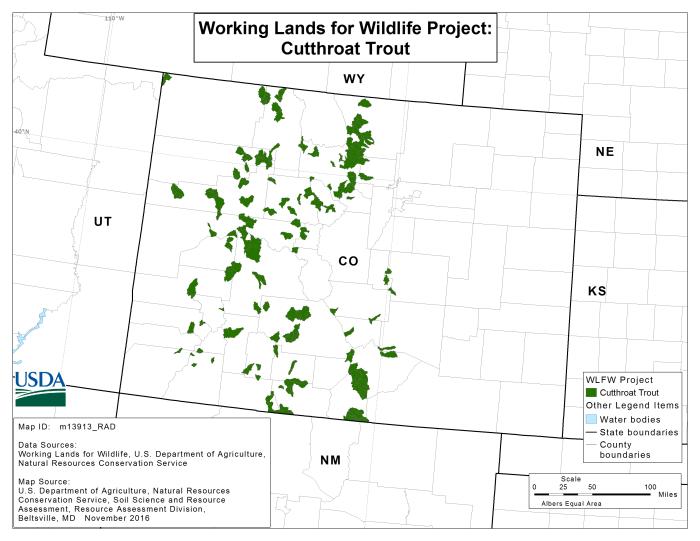Cutthroat Trout
Colorado's mountainous terrain kept individual “pods” of cutthroat trout isolated and their gene pools limited from encounters with other trout during their evolution.

Colorado's mountainous terrain kept individual “pods” of cutthroat trout isolated and their gene pools limited from encounters with other trout during their evolution. Today, there are 14 recognize subspecies of cutthroat trout, including three in Colorado, including the Colorado River, Greenback and Rio Grande subspecies.
The Greenback cutthroat trout is listed as threatened under the federal Endangered Species Act and threatened at the state level. The Colorado River and Rio Grande cutthroat trout are considered species of special concern in Colorado. All three fish are declining because of the spread of non-native fish species as well as the loss and degradation of habitat. Degraded streams often have less streamflow, an altered hydrology, a lack of resting cover and food sources, and too many nutrients and sediment. To help reverse population declines, NRCS is working with private landowners in targeted basins across Colorado to increase available riparian habitat to support the species’ recovery.

Landowners in the Arkansas, Dolores, Gunnison, Upper Green, Upper Colorado, Yampa, White, Rio Grande, San Juan and South Platte basins in Colorado are helping the cutthroat trout by improving riparian habitat. NRCS is helping them create spawning areas, enhance in-stream cover, provide overhanging bank vegetation and install fish passage and fish screens.
NRCS offers technical and financial assistance to help landowners improve riparian areas. This assistance helps producers plan and implement a variety of conservation activities, or practices, that benefit the cutthroat trout any many other species.
Technical assistance is free to producers. The agency’s staff of experts and conservation partners work side-by-side with producers to develop a conservation plan. Each plan focuses on the improvement of cutthroat trout habitat and is tailored to the landowner’s property. These plans provide a roadmap for how to use a system of conservation practices to meet natural resource and production goals.
Financial assistance helps producers pay for the adoption of conservation systems that improve the health of riparian ecosystems. The project’s core conservation practice is stream habitat management and improvement.
The cutthroat project is part of the Working Lands for Wildlife (WLFW) partnership, a collaborative approach to conserve habitat on working lands. WLFW provides technical and financial assistance through the Environmental Quality Incentives Program and Conservation Stewardship Program, conservation programs of the Farm Bill, the largest funding source for conservation on private lands.
Habitat restored for cutthroat benefits many other species, including yellow-billed cuckoo, southwestern willow flycatcher, New Mexico meadow jumping mouse, humpback chub, razorback sucker and river otter.

